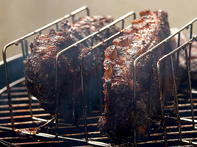The smoking of foods is an ancient practice; one of the first methods of cooking and preserving foods like meat and fish. Modern applications of smoking as food processing include marinating the meat before smoking, the use of different types of wood chips to impart different flavours, smoking food items such as cheese and vegetables and the development of liquid smoke.

How to Smoke Foods
Hot smoking of foods is done over a heat source to which woods chips or sawdust are added. Liquid smoke can also be used.
Smoking imparts a flavour to foods and has a small preservation effect as it causes the drying of the exterior of the food product. To counteract the drying effect of smoking, foods are often marinated or left in a savoury brine before the smoking process begins. The limited preservative effect of smoking can be enhanced by cooking or salting of the product.
Hot smoking is done in a smoker where the temperature is increased to allow for a fully-cooked product. Smouldering wood chips or sawdust, added to the heat source, cause smoke which imparts the flavour to the food.
Hot smoking of foods is a modified cooking technique that allows for the smoking as well as cooking of the meat.
A few rules should be followed to allow for food safety:
Only thawed food should be smoked. Do not smoke partially frozen meats as this can result in the internal temperature not reaching high enough temperatures to destroy any harmful microbes.
Always brine or marinate the food in the refrigerator.
Use thermometers to measure smoke temperature as well as inside meat temperature.
Beef and pork should reach an internal temperature of at least 62℃, hot-smoked fish should reach at least 66℃ and poultry should cook to a final internal temperature of at least 74℃.
Smoking only has a limited preservative effect and smoked foods should be handled and stored like any other cooked product.
Cool rapidly after smoking - large pieces of meat may need to be cut smaller - and store smoked foods in a refrigerated area for a maximum of three to four days.
Smoked fish freezes between 2 - 5°C.
Wood Chips for Smoking
The type of wood chips used for smoking foods will determine the strength and flavour of the smoke profile. Wood from fruit trees - pear, apple, peach or cherry wood impart a sweeter flavour and is popular for use with poultry and fish.
Meats like pork and game produce delectable flavours when smoked with hickory, maple, pecan and oak wood chips. Sometimes plants like rosemary or even rooibos are added to impart a more herbal smoked flavour.
Buy wood chips from a reputable retailer. Never use treated and painted wood or wood such as pine, cypress or cedar. Poisonous wood includes tamboti and oleander. Wood from fruit orchards may contain residual chemicals.
Cold Smoking
Cold smoking of foods involves smoking of the product without cooking it. The product is often brined before smoking as the brining will have a better preservative effect than the low-temperature smoke.
Cold smoking is often a slow extended process (ranging from 6 to 24 hours for fish) with temperatures around 30℃.
Cold smoking is suitable for cheese but is also used for smoking fish and to impart a smoky flavour to nuts, garlic, olive oil, eggs, tofu and vegetables.
Liquid Smoke
Liquid smoke is a red to yellow-coloured water-soluble liquid made from the condensate of wood smoke. Food can be dipped in solutions or left to marinate in brines containing liquid smoke.
Liquid smoke can also be added to cheesy dips, oils and sauces. Adventurous gourmands also use it in cocktails and dessert where the smoky flavour pairs well with caramel and dark chocolate.
The two advantages of liquid smoke are that the smoke flavour can be exactly controlled and the flavour is immediate.
Smoked Food Products
Popular smoked meats include ribs, beef brisket, bacon, pastrami, Kassler, gammon and hams such as Eisbein and Black Forest ham.
Examples of smoked sausages are bockwurst, chorizo, cabanossi, salami and Vienna sausage while smoked fish such as smoked trout, salmon, cod, herring, eel, haddock, catfish and sardines are well-known.
Other smoked foods like cheese, nuts, smoked-flavoured oils and smoked and grilled vegetables like corn-on-the-cob and potatoes are also gaining in popularity.
By Marinda Louw